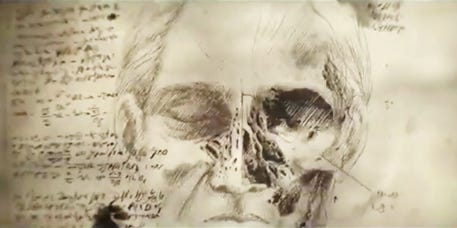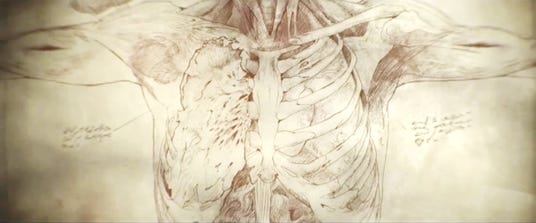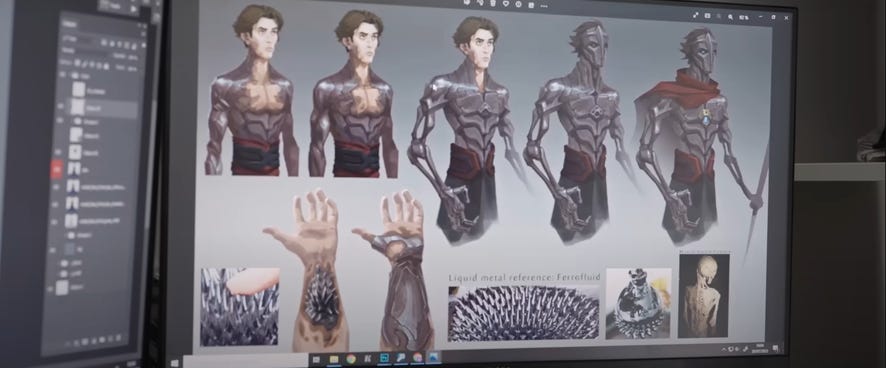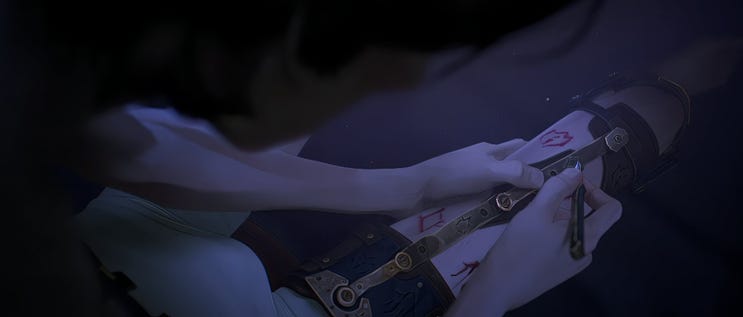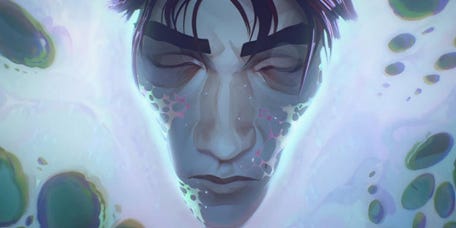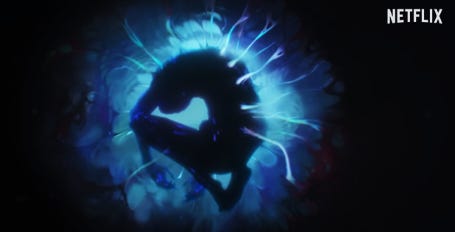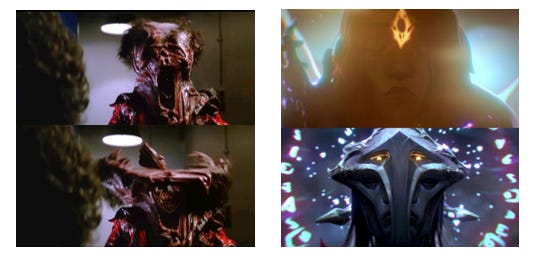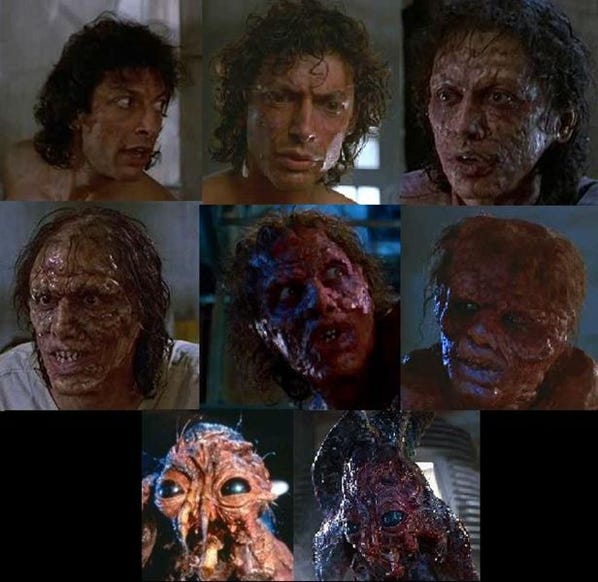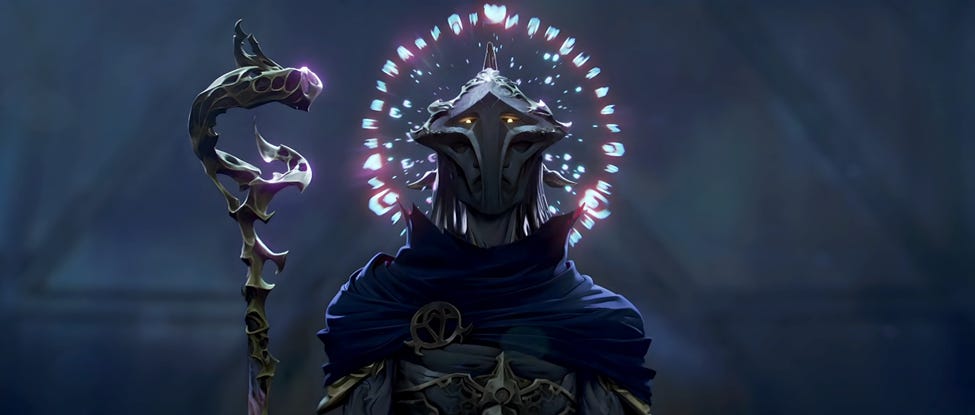Introduction
Many people fear physical changes every day. The appearance of wrinkles, age spots, or unexpected bumps reminds us of human finitude, evidencing that every minute lived inevitably brings us closer to death. This process can cause the body to be perceived as a hostile space, a source of discomfort, and even repulsion. The horror subgenre known as body horror is based on this premise.
Body horror focuses on the disturbing transformations and extreme degradations of the human body, provoking a reaction of discomfort and fear in the viewer. These representations often show grotesque alterations that include diseases, mutilations, zombifications, and unnatural movements, thus revealing the frailties of the human condition.
In the words of Antonin Artaud, "The body is the body, it is alone and has no need for organs; the body is never an organism, organisms are the enemies of the body. (...) Each organ is a parasite destined to make to live a being that has no reason to be there" (Artaud, 1997, p. 314). This vision, in line with body horror, proposes an image of the body as a battlefield where its natural functions can become a threat.
In the audiovisual field, recent productions such as Arcane, the animated series inspired by League of Legends (a collaboration of Netflix and Riot Games), have included elements of body horror to explore physical vulnerability, although characters with severe body modifications are observed. one in particular that stands out: Viktor. Presented with a physical disability that forces him to rely on a cane and a brace on his left leg and back, Viktor's body is something that is shown to be constantly evolving or devolving. As the plot progresses, it is revealed that Viktor suffers from a life-threatening degenerative disease, but it is also suggested that he could find an alternative to survival through experimental interventions, symbolized in the use of the "shimmer" and the "Hex core" .”
In this sense, the series brings to the table the element of body horror that not only exhibits the vulnerability of the human body but also explores the frontiers of biology and technology, delving into themes of identity and the struggle to preserve existence, facing physical degradation, and the ethical dilemma about eliminating a disability.
This essay is based on my knowledge of body horror and my personal experience as someone living with a chronic pain illness.
It is important to note that disability and chronic pain are different concepts, although they can coexist in some people. Disability usually refers to a condition that significantly affects one or more areas of a person's life, while chronic pain is characterized by a prolonged experience of pain that may not be directly related to a disability.
I make this point from my personal experience as someone who lives with chronic pain, a condition that, although not always considered a disability, has a profound impact on my ability to perform many daily activities. Watching Viktor's story, I couldn't help but reflect on his constant struggle to cope with a body that seems to be against him.
Chronic pain is an invisible challenge for those who do not suffer from it. It is an experience that transcends the physical, also affecting mental and emotional health. In Viktor's narrative, this aspect is clearly shown: his illness limits him physically, but it also drives him to desperately search for a way to overcome those barriers. This representation resonates deeply with those of us who face these types of conditions, as it reflects the universal desire for relief and autonomy, but also the ethical and emotional complexities that arise along this path.
When expanding this idea, it is essential to avoid an ableist approach. People with disabilities or chronic conditions are not inherently "less" because of their physical or health limitations. Viktor, despite his illness, is a character who demonstrates resilience, intelligence, and an unwavering will to change his world. His story should not be seen as an attempt to "fix" his body, but as an exploration of what it means to be human and how adverse circumstances can shape, but not define our essence.
What is body horror?
Body or biological horror (body horror in English) is a subgenre of horror cinema that explores grotesque and disturbing human body alterations, generating a reaction of discomfort or repulsion in the viewer (Cruz, 2012). Such alterations may involve diseases, deviant sexual practices, mutations, mutilations, zombifications, explicit violence, or unnatural movements.
This subgenre is characterized by representing physical transformations that affect the human body in such a way that they cause a feeling of disturbance in the viewer. Frequently, these symbolic transformations address deep cultural or personal anxieties, such as fear of death, aging, illness, or loss of control over one's body (Novak, 2024). Through deformities, infections, and transformations that defy biological logic, body horror presents the body as a vulnerable and fragile entity, susceptible to corruption and disintegration.
Focused on the limits and transformative capacities of the body, body horror highlights the precariousness of the human form (Cardin, 2017). Although initially used to refer to a subgenre of American horror cinema, the term body horror has its roots in early Gothic literature and has expanded into other media of expression (Halberstam, 1995).
The visual alteration of the body acts as a symptom of a latent anomaly that bursts into everyday life, transforming the body into something alien and transgressive (Martínez Labra, 2022). David Cronenberg, noted director and pioneer of body horror, explores fear of viral infections, mutations, and the fusion of technology and biology. These representations invite reflection on the interrelation between the physical and the psychological, unraveling the anatomical and mental fragility of the human condition (Brito Alvarado, 2024).
The term was formally coined in 1986 by the academic magazine Screen, which classified body horror within the genre of science fiction with horror nuances. This type of cinema began to become known in the late 1970s and 1980s (UNIVISIÓN, 2016), although its origins can be traced to films such as Frankenstein (1931) and Cat People (1942). In essence, body horror encompasses all types of physical transformations and destructions, manifesting bodily alterations without established limits.
Many stories explore the idea of grotesque and unwanted physical changes. This may include mutations caused by diseases, scientific experiments, or external forces, reflecting the fear of losing control over one's body (Coliva, 2023).
The main characteristic of body horror is the transformation and mutation of the body, regardless of its etiology. From this premise, the following characteristics are derived:
● Loss of Autonomy: Body horror often depicts the loss of conscious control over the body, whether through illness, possession, or mutation. This theme is associated with anxiety about physical vulnerability and the inability to manage what happens with one's own body (Coliva, 2023; López, 2024).
● Violation of the Body: Many narratives address the violation of the body, either literally or metaphorically. This can manifest itself in contexts of medical abuse, experimentation, or situations that lead the body to a state of extreme suffering (Coliva, 2023; Novak, 2024).
● Identity Crisis: As characters undergo bodily transformations, they often face existential crises. Physical alteration can lead to questions about identity and what it means to be human (Novak, 2024).
● Repulsion and Disgust: Body horror seeks to provoke visceral reactions in the audience, using disturbing images to evoke feelings of disgust and fear. This connects to the idea of the abject, where the grotesque is presented in the foreground to impact emotionally (Novak, 2024).
● Femininity and the Body: In many contemporary works, especially those directed by women, female experiences related to the body are explored. This includes topics such as menstruation, pregnancy, and social expectations about physical appearance, offering a unique perspective on body horror (López, 2024).
Joyce Carol Oates (s. f. cited in López, 2024) states that body horror is directed more strongly at women and girls. To be a woman is to inhabit a body that by nature is vulnerable to forced invasion, susceptible to penetration and pregnancy, and condemned to suffer childbirth.
● Social Connection and Isolation: In the modern context, some body horror stories reflect feelings of social disconnection and isolation, especially after traumatic events such as the pandemic. Body transformations can symbolize a struggle to reconnect with oneself and others (Novak, 2024).
Aida Méndez and Elena Lombao (cited by López, 2024), also known as Bloody Girls on social networks and other internet spaces where they spread their knowledge, propose that body horror is a subgenre “very subversive to the extent that it attacks the human body.” proposing its disintegration or its monstrous drift,” they say.
Sarai Herrera, editor of Horror Vacui, states: “In the end, the body is the last thing that belongs to the dispossessed, so it is the only terrain over which we can have control, consciously or not” (López, 2024).
For her part, journalist Anne Elizabeth Moore, in her book Body Horror: Capitalism, Fear, Misogyny, Jokes (Paperback Edition, 2023), describes the evolution of the term body horror. In an interview for Literary Hub, she explains: “Originally, [the term body horror] applied to any horror story involving the body, but it has now come to refer to something more specific: a focus on bodily changes, in particular those stories that offer a visceral sensation of the body transforming.” Furthermore, he adds: “Having a monster in a horror movie doesn't make it body horror, but when the story is told from that monster's point of view, it is.”
Who is Viktor in Arcane?
Viktor is a central character in the animated series Arcane, based on the universe of the League of Legends video game. In the adaptation, he is introduced as a young researcher at Piltover, an assistant at the Academy and a close collaborator of Jayce in the development of Hextech technology; technology based on magical runes that can improve the quality of life of people who use them. Unlike his representation in the video game, where he is described as the "Herald of Machines" and is characterized by his obsession with mechanical evolution, Arcane introduces a more complex and human version of Viktor, guided by personal aspirations and conflicts that They lead to challenging established norms (Runas, 2022).
In the narrative, Viktor is initially shown assisting in the investigation of a robbery at Jayce's laboratory, committed by Powder, Violet, Mylo, and Claggor. As assistant to Dean Heimerdinger, who also sits on the Piltover Council, Viktor combines his academic support role with a growing interest in technology and its potential applications to improve human life. Faced with Jayce's expulsion from the academy, Viktor decides to risk putting his career in danger with the intention of helping Jayce develop this magic-based technology that is still presented as very unstable.
During the first act, Viktor is presented as a character with an obvious limp, assisted by a cane and whose origins dating back to childhood in the impoverished city of Zaun are central to his identity. In his dialogues, Viktor expresses that, due to his poverty and physical condition, few people trusted his abilities as a scientist once he arrived at Piltover; However, his resilience and cunning allowed him to thrive, even at the cost of challenging certain norms. This initial characterization suggests that Viktor is willing to bend the rules in pursuit of his goals, motivated primarily by his desire to improve living conditions in Zaun by developing Hextech technology alongside Jayce.
The narrative takes an important turn in the second act, which shows the characters after a time lapse of approximately seven years. Upon his return, Viktor appears visibly paler and thinner, with a hunched posture and now assisted by a crutch instead of a cane, indicating a progressive deterioration in his health. This physical change is confirmed by the medical diagnosis he receives in later episodes, following the collapse in the laboratory, where it is suggested that his condition is serious and could limit his life expectancy.
It is hinted that Viktor's illness may be a result of exposure to toxic gases during his time in Zaun, a hypothesis mentioned by Jayce in a conversation with Councilwoman Mel. Furthermore, the series reinforces this possibility by showing scenes in which Zaun's environment is revealed to be contaminated, with water possibly saturated with oils or heavy metals, in which children play without any protection.
Already in the first act of the second season, it is revealed that a large part of the residents who worked in the mines suffered from the El Gris plague, a highly concentrated type of smog that caused mutations and malformations in people who were highly exposed. Children who live near factories and industrial facilities have been shown to develop asthma and other respiratory diseases and even some types of cancer.
Note: Effects of El Gris on people's bodies exhibited in Arcane (Linke and Yee, 2021 - 2024)
In the series, no specific diagnosis is provided for the illness that afflicts Viktor, but the audience has speculated about his condition based on the symptoms he presents. Among the possible conditions suggested are rickets, autoimmune diseases, some type of cancer and, notably, Atypical Hemolytic Uremic Syndrome (aHUS), the latter gaining more acceptance due to the similarity to the symptoms observed in the character.
Atypical Hemolytic Uremic Syndrome (aHUS) is a serious disease that presents the following characteristics, according to Campistol et al. (2012):
● Microangiopathic Hemolytic Anemia: This form of anemia is characterized by a negative result in the Coombs test, which indicates non-immune hemolysis. Patients usually have elevated levels of lactate dehydrogenase (LDH) and reduced levels of haptoglobin. In simpler terms, anemia occurs because red blood cells break down when trying to pass through vessels that are not in good condition, and not because of a reaction from the immune system.
● Thrombocytopenia: A significant decrease in platelets in the blood is observed, frequently associated with the formation of thrombi, which can be serious. That is, when there are very few platelets in the blood. This can be dangerous because platelets are responsible for helping blood clot properly. In some cases, a lack of platelets is linked to the formation of small clots (thrombi), which can cause serious complications if they block blood flow in the body.
● Acute Kidney Failure: Kidney involvement can manifest itself in acute damage and even evolve into chronic kidney disease or end-stage renal failure.
These manifestations generate serious physical limitations and represent a considerable threat to the patient's life. The prognosis is typically poor, as more than 50% of those with aHU may die or develop chronic kidney failure in the first year after diagnosis. Mortality after a first episode of the disease is estimated at 10-15%.
At the end of 2024, in the Making Arcane video | Arcane: Season 2 on Netflix, the creators revealed that Viktor was initially going to suffer from fibrodysplasia ossificans progressiva (FOP). This is a rare genetic connective tissue condition that is characterized by the abnormal development of bone in areas where there normally should not be any, such as ligaments, tendons and skeletal muscles (heterotopic ossification). This disorder causes skeletal muscles and other soft tissues in the body to transform into bone, eventually limiting or completely eliminating joint mobility (National Organization for Rare Disorders [NORD], 2020).
Note: First concepts for the design of Viktor/ Machine Herald (Still Watching Netflix, 2024)
Likewise, it is observed in the series that Viktor's condition is terminal, thus being a great motivation for the character's actions and that it has its consequences, for example:
Viktor's illness severely affects his quality of life, causing symptoms such as extreme fatigue and weakness, and causing a noticeable limp that affects both his mobility and self-esteem within Piltover society. Furthermore, in two particular scenes it is observed that he coughs up blood, indicating an alarming deterioration of the tissues. These physical difficulties not only limit his daily functionality, but also influence his perception of himself and his place in the scientific and social environment (Villalobos, 2023a; Villalobos, 2023b), preferring to walk mostly in the shadows away from the light of the spotlight unlike Jayce, who is the face of the city's progress.
Viktor's condition also affects his emotions and personal relationships, creating feelings of isolation and despair. His illness and his perception that time is running out generate episodes of introspection and hopelessness, affecting his relationships, especially with Jayce, who symbolizes both friendship and professional competence (Razablan, 2021). This internal conflict drives Viktor to question not only his work, but also the meaning of his life and the purpose of his effort.
Body horror, degenerative diseases and body modifications: What would you be willing to do to change your sick body for a new one?
The archetype of the "mad scientist" who crosses ethical and legal boundaries with the goal of achieving a greater good—antidotes, serums to prevent diseases or cure conditions such as old age or cancer—is recurrent in fiction. Classic examples include films such as Frankenstein (1931), Dr. Jekyll and Mr. Hyde (1941), The Brain That Wouldn't Die (1962), and Re-Animator (1985), among others.
Viktor's health began to deteriorate most rapidly at the time of the most promising phase of research. His occasional fatigue and nosebleeds revealed a devastating truth: his condition was terminal and he had just weeks to live.
This news changed everything about Viktor's approach to his work. His behavior changed as he worked with renewed urgency and skipped sleep and proper nutrition. Hexcore, his innovative creation, became more than just a breakthrough: it became his last hope for survival.
Viktor tried increasingly risky experiments because he needed solutions. Traditional methods failed, so he reached out to his old acquaintance, Singed, the controversial scientist from his past. This choice became a vital turning point, leading Viktor to try dangerous combinations of shimmer and hextech.
Viktor personally felt the price of progress. His body failed more and more each day, but his mind remained alert and determined. Everyone saw his struggle between maintaining scientific ethics and his desperate need to survive, while also trying to maintain his partnership with Jayce, who cared more about where his research was going. The desperate fight for survival through the Hexcore marks something unprecedented in Piltover's scientific history. His innovative creation, the Hexcore, was an adaptive rune matrix that could shift and transform organic matter, a possible cure for his terminal condition.
The Hexcore's true potential emerged after Viktor made a bold decision. He took the glow of his former mentor and injected it into his system to help his body accept the transformative powers of the Hexcore. The changes came immediately: his crippled leg became a functional robotic limb. I could run for the first time. His physical strength grew substantially. Their neural connections adapted to the mechanical parts.
Body horror and the concept of the mad scientist are closely related. The search for a cure for degenerative diseases, for example, arises from the fear of physical decay and the desire to avoid or at least delay inevitable bodily deterioration. In Viktor's case, his degenerative disease drives an obsessive dedication to scientific research, particularly in the development of Hextech and the Hextech Core. These technologies represent his desire to overcome his physical limitations and leave a significant legacy.
However, this ambition places him in the face of ethical dilemmas. The technologies that Viktor develops have unpredictable side effects, which generates internal conflicts about the limits between science and morality (Villalobos, 2023a). Although the series incorporates magical elements into its narrative, particularly in the second season, the themes related to body horror—body transformation and the loss of autonomy over oneself—remain central.
Throughout the series, Viktor goes through multiple physical transformations, almost always without the possibility of deciding about them. His body seems doomed to be the scene of outside interventions, from the effects of his degenerative illness to the forced resurrections that turn him into something beyond human. However, in two specific moments in the first season, Viktor makes a decision about his own body, introducing an even more disturbing element of body horror: self-mutilation.
Note: Viktor carving runes into his body (Linke and Yee, 2021 - 2024)
The first case occurs when Viktor, desperate due to the progression of his illness and the limitations of his body, decides to voluntarily submit more of his blood to the Hextech Core, injecting himself with shimmer, and marking runes on his body and on his braces to survive the process. of change. This act, although vested with autonomy, is driven by a mixture of desperation and blind faith in technology, which leads him to accept a procedure that irreversibly alters his physiology. This transformation, while granting him some relief and new abilities, also highlights the inherent tragedy of body horror: the need to harm one's body in order to survive or improve. The self-mutilation here is not just physical, but symbolic, representing the loss of what little control and humanity he had left.
Self-mutilation in the context of body horror adds layer of philosophical and emotional complexity. While many works in this genre explore how external forces invade or violate the body, Viktor becomes the agent of his transformation, raising disturbing questions about the relationship between the body and identity. How much of our humanity depends on our flesh? Is it possible to redefine ourselves through our actions, even if these involve giving up who we physically are?
Viktor's self-mutilation is not only a desperate act, but also a declaration of his priorities: for him, the body is secondary to his goal of transcendence and progress. Self-mutilation, in this sense, not only transforms his body, but also decomposes his identity, taking him to a point where neither he seems to recognize himself, nor those around him such as Professor Heimerdinger, a mentor who manages to detect that something in him changed because of its discovery.
Finally, these decisions reveal another terrifying facet of body horror: limited agency. Although Viktor appears to make these decisions, they are deeply conditioned by his context, his illness, and his obsession with overcoming his limitations. This leads us to reflect on the extent to which our decisions about our own body are truly free, and how the desire to transcend can lead us to sacrifice fundamental aspects of who we are.
Furthermore, the loss of autonomy is repeated when the Hextech Core, which initially represents a hope to overcome his limitations, soon appears to exert control over him, as evidenced when he attempts to get rid of it without success.
Already in the second season, even after his apparent death in the attack on the council caused by Jinx, Viktor is resurrected by Jayce using the Hextech Core. Later, he dies again in the colony, this time at the hands of his best friend and colleague, only to be revived by the alchemist Singed.
It is then that he becomes the Herald of the Machines, a figure that symbolizes his final renunciation of humanity, especially when his face is divided into two halves, something that remind me of the blood test scene from The Thing (1982) by John Carpenter, a disturbing image for some viewers, but a trick commonly used in the aforementioned genre where the body twists, deforms, stretches and transforms in unnatural ways. This change marks the redesign of his iconic mask, erasing every vestige of humanity that still remained in him.
Note: Blood test scene from The Thing (1982) vs. Viktor becoming Machine Herald (2024)
Viktor's transformation resonates with the approach used by David Cronenberg in his version of The Fly. In this film, Seth Brundle's character, another scientist trapped in his obsession with his invention, undergoes a grotesque and dehumanizing metamorphosis after an accident in his teleportation experiment. Cronenberg meticulously portrays this transformation: from the deterioration of his skin, the loss of his hair, nails, and teeth, to the final loss of his human eyes. This last detail is not accidental.
Cronenberg saves the transformation of Seth's eyes— considered a window to the soul— for the film's climax. In doing so, he uses this element as a symbol of the last vestige of humanity he has left. When his eyes finally lose any human trace, his transformation into Brundlefly is sealed, an abomination without identity or human essence. This narrative choice amplifies both the visual horror and the emotional tragedy, making Seth's loss of humanity especially shocking to the viewer.
Note: Seth Brundle's transformation process in The Fly (1986) dir. David Cronenberg
Comparing this approach to Viktor's case, the animators, or the designers of his character in the game, seem to have sought to convey a message similar to Cronenberg's. Throughout the series, Viktor retains traits of his humanity, even in the darkest moments of his life. However, after his resurrection at the hands of Singed, he abandons the face that his colleagues knew, including the emotions it reflected. His eyes, now replaced by yellow orbs devoid of all expression, symbolize not only the loss of his humanity but also his conscious rejection of emotions, which he himself considers people's greatest weakness.
In this way, in both The Fly and Arcane, the transformation of the eyes serves as a powerful narrative symbol, representing the endpoint of the struggle between the human and the monstrous. For Viktor, this change not only redefines his physical identity but also his purpose, as he fully embraces his new nature as the Herald of the Machines.
These events underscore Viktor's lack of autonomy over his own body. Even in the colony, when attempting to heal others affected by physical afflictions caused by the Shimmer or other factors, such as Vander and Salo, the use of his powers weakens him considerably. This reinforces the idea that, despite all his efforts, Viktor never achieves full control over himself.
In episode 6, during his reunion with his former master Singed, Viktor reflects on his view of evolution, mentioning: “Evolution has a destiny: not to combat nature, but to replace it. The final Glorious Evolution.”
What does it mean for evolution to replace nature?
Viktor's "Glorious Evolution", in both League of Legends and Arcane, represents his philosophy on human progress through technology. As the Herald of the Machines, Viktor dedicates his life to the betterment of humanity through technological advances, maintaining that the evolution of the human species is intrinsically linked to the ability to adopt and adapt to technology.
For Viktor, the personal transformation facilitated by Glorious Evolution symbolizes continuous progress. Each improvement in his body reflects his desire to transcend human limitations, seeking to become a more efficient and powerful entity. Although its initial objective focused on improving the quality of life, its philosophy evolves towards a more radical belief: only by embracing the mechanical and the technological can humanity reach its maximum potential.
This ideal transcends his body and extends to his vision of a world transformed by technology. Viktor not only wishes to overcome his own limitations but also to free humanity from the imperfections that, in his perception, condemn it to suffering. However, this utopian aspiration is tinged with a dark undertone. His story offers an implicit critique of the obsession with unbridled progress, which often ignores the ethical and social implications of altering what is human.
As Glazebrook (2024) points out on ScreenRant:
"Viktor is described as 'The Machine Herald' and strives for something he calls glorious evolution. In Viktor's mind, the human body is inherently flawed – linking back to his character who suffers from a body-related illness in Arcane – and needs fixing. Viktor's way of fixing the human body's flaws involves combining it with machinery."
This perspective is revealed in episode 9 of the second season, when Viktor makes drastic decisions that take away other people's autonomy, convinced that doing so will free them from their suffering. His belief that all of humanity is trapped in a constant physical or emotional struggle leads him to position himself as a savior, using his powers and machinery to “free” others from these burdens.
With this, Viktor not only becomes a symbol of excessive ambition, but also a warning about the dangers of reducing the complexity of the human experience to a problem that can be “solved” only through technology.
Viktor, Body Horror and Plato's Dualism: The sick body and the free mind
Plato, in his dualist conception, establishes a fundamental distinction between the body and the soul. According to the philosopher, the body is material, corruptible, and mortal, while the soul is immaterial, immortal, and the true source of knowledge. This approach sees the body as a "prison" for the soul, an obstacle that limits its ability to achieve truth and full knowledge.
This philosophical concept resonates deeply in the narrative of Viktor, who perceives his diseased body as a barrier to achieving significant advances in both science and his own existence. The phrase attributed to patients with disabling illnesses or disabilities— “It's not me who is sick, my body is”—perfectly encapsulates this idea. Viktor, like these people, views his body as a prison from which he cannot escape, a constant reminder of his fragility and finitude.
The user @godlessbot, on the X platform (formerly Twitter), approaches the topic from a contemporary perspective and summarizes it simply:
"Body horror takes concepts like fear, disgust, pain and evil, and places them in the body. You can move out of a haunted house, but our physical form is something much harder to leave."
This reflection connects directly with the body horror genre, which explores the intrinsic terror of being trapped in a body that degrades, transforms, or rebels against its own being. In the case of Viktor, his struggle to overcome physical limitations becomes a metaphor for this body horror, where his body is not only the scene of his illness but also the place where his internal conflict between humanity and transcendence resides. technological.
Plato reinforces this view by arguing that true knowledge and fulfillment can only be achieved when the soul is freed from the bonds of the body. In his dialogues, the philosopher emphasizes that the senses, linked to the body, are deceptive and that only through reason can one access the Eternal Forms or Ideas, which represent the absolute truth.
This dichotomy between body and soul, reason and emotion, is also manifest in Arcane, especially in episode 6, when Viktor reflects:
"Humanity, our very essence, is inescapable. Our emotions: anger, compassion, hatred. Two sides of the same coin, inextricably linked. That which inspires us to our greatest good is also the cause of our greatest evil."
Here, Viktor articulates a conflict similar to the one Plato describes: emotions and the body, although essential to human experience, are also sources of error and suffering. Viktor not only views his body as a physical limitation but also perceives emotions as an impediment to rational progress. His quest for Glorious Evolution—an ideal where the mechanical replaces the biological—reflects his desire to overcome these limitations, both physical and emotional, and achieve a higher state of existence.
However, this rejection of the body and emotions raises deep questions about what it means to be human. By embracing technology as a means of transcendence, Viktor embodies a modern critique of Platonic dualism: what happens when, in the attempt to free ourselves from the “prison” of the body, we also sacrifice what makes us human?
So what makes Viktor Viktor?
It is a complex topic and to this day debates continue about what makes a human being “human”? I once posted:
“If you are familiar with the body horror subgenre the main question is “what makes a human being a human?” “Is someone a human even if his body is severely modified by emergencies or diseases? Or can someone be considered as a human just for looking like one?”
When did Viktor stop being human? When did he become the herald of the machines or long before, when his own body turned against him?
Putting myself in the role of devil's advocate, I find that I can defend many of Viktor's actions, or at least empathize with them, especially from the perspective of someone who also suffers from chronic pain. When you have the flu, you take a flu medicine and eventually you get better. If you break a bone, they put you in a cast and, after a while, you heal. But chronic pain is different. The word "chronic" itself indicates that there is no cure. Some medications can relieve pain and good days where the discomfort is more manageable, but the pain never completely goes away; It is always there, like a shadow that follows you and threatens to intensify.
Living with chronic pain means that suffering becomes a constant part of your existence. It comes to dominate your thoughts since it is almost impossible to concentrate on anything else. There are times when you desperately want to escape your own body, even for a moment, just to feel relief.
The fundamental difference between my experience and Viktor's is that, for him, there was tangible hope for a cure. The Hextech Core offered a chance to not only alleviate his suffering but to regain something that had been denied him his entire life: autonomy over his own body. In episode 7 of the first season of Arcane, we see a glimpse of this miracle. Viktor, for the first time in years, runs along the dock, a simple action but loaded with symbolism.
This scene draws a parallel with the previous episode, where we were shown a young Viktor unable to run after his boat due to the physical limitations imposed by his illness.
That moment of freedom, although brief, encapsulates what some people with a disabling condition long for the chance to take back something their body has taken from them. For Viktor, the Hexcore was not just a technological tool; It was a bridge to life without chains, a promise that the pain could end.
From this perspective, his decisions, although morally questionable, become understandable. Viktor sought not only to transcend his physical limitations but also to overcome the despair that accompanies constant chronic pain. Her story is a reminder that when hope appears, even in dangerous or unorthodox forms, it is difficult to resist.
That is why, many of the viewers – myself included – can empathize and even sympathize with their actions, if you are in that situation, in that body that hurts all the time without any relief, wouldn't you do something to stop it?
Conclusion
Viktor stands out in Arcane as a symbol of the true cost of progress. This brilliant scientist, born in the toxic conditions of the sub city of Zaun, embodies one of the series' most powerful narrative arcs: the transformation of a disabled young inventor into a cybernetically enhanced being. His story, marked by his interaction with a terminally ill Viktor and his desperate search for answers through Hexcore technology, raises profound questions about the boundaries between advancement and preservation, ambition and survival.
Viktor's narrative, deeply influenced by degenerative diseases, body modifications and ethical dilemmas, is configured as a masterpiece of body horror. This genre takes our fears of body transformation and identity erosion to the extreme. Viktor reflects human struggles to overcome physical limitations, but he does so at a devastating cost: the loss of his essence.
Body horror finds its strength in the fear that the body, that intimate space that we believe we control, becomes strange or threatening. In Viktor, this fear is intensified by his conflictive relationship with his body: since childhood, he has suffered the burden of a degenerative disease that limits his autonomy. This conflict escalates into adulthood, when his body becomes a battleground between his aspirations, the technology he develops, and the decisions of outside figures like Jayce and Singe. The transformations he undergo not only alter his physique but progressively strip him of his humanity.
However, body horror in Viktor goes beyond the physical dimension; and introduces deeply disturbing existential and philosophical questions. One of the most fundamental is: what does it mean to be human? His narrative reflects a dualistic vision of the body as a prison for the soul, a concept that resonates with Platonic philosophy. In his attempt to transcend his mortal flesh and physical limitations, Viktor loses something essential: his connection to his humanity.
Viktor's humanity is not only affected by his physical transformations but also by the fragmentation of his mind and emotions. His social isolation, his distancing from Jayce, and his inability to connect with others reflect a profound disconnection. His face, transformed into a metal mask, symbolizes both the loss of his human appearance and his ability to express empathy and emotions, aspects that he begins to consider weaknesses.
Body horror amplifies this disconnection, confronting us with an uncomfortable truth: our humanity is intrinsically linked to our imperfection. Viktor, in his quest to perfect his body and mind, strips away the elements that connected him to others and to himself. In his transformation into the machine, he sacrifices the emotions that defined him, becoming a tragic reflection of our obsession with perfection.
Viktor's story not only explores physical and existential fears, but also highlights the importance of approaching topics such as chronic pain and disability from an ethical and empathetic perspective. Although exaggerated by fiction, their struggle represents a real experience for many people. This narrative invites reflection on how to balance technological advancement with respect for the dignity and humanity of those facing these struggles.
Ultimately, Viktor is not just a character who undergoes transformations; It is a mirror that invites us to question our own perceptions of the body, identity, and humanity. His story offers no easy answers, but rather a disturbing warning: in our struggle to transcend our limitations, we risk losing what makes us human. In the fragile balance between body, min,d and soul, Viktor reminds us that humanity is not something we can perfect, but something we must accept in its complexity and vulnerability.
References
Artaud, A. (1977). Van Gogh: el suicidado de la sociedad y para acabar de una vez con el juicio de dios. Fundamentos
Brito Alvarado, X. (2024). Del horror a la trasmutación corporal en el cine de David Cronenberg. Ética Y Cine Journal, 14(2), 73-83. https://revistas.unc.edu.ar/index.php/eticaycine/article/view/45761
Cardin, Matt. (2017). Horror Literature Through History: an Encyclopedia of the Stories That Speak to Our Deepest Fears [2 Volumes]. Santa Barbara, California: Greenwood.
Coliva, A. Y. (2023, 17 diciembre). Body Horror, la ansiedad post-pandémica reflejada en los juegos de terror | Nota al Pie | Noticias en contexto. Nota Al Pie. https://www.notaalpie.com.ar/2023/12/17/body-horror-videogames-post-covid/
Cruz, R. A. L. (2012). Journal of Popular Film and Television 40 (4): 160-168.
Glazebrook, L. (2024, 9 noviembre). What Happened To Viktor In Arcane: New Body, Powers & Meaning Explained. ScreenRant. https://screenrant.com/arcane-viktor-machine-herald-body-powers-explained/
Halberstam, J. (1995). Skin shows: Gothic horror and the technology of monsters. Duke University Press.
López, C. (2024, 26 octubre). El gusto por lo repugnante: la perversión del «body horror» escrito por mujeres. El Diario. https://www.eldiario.es/cultura/libros/gusto-repugnante-perversion-body-horror-escrito-mujeres_1_11763910.html
Martínez Labra, T. (2022). Lo abyecto y lo siniestro en el horror corporal. Una perspectiva psicoanalítica y afectiva. Revista de Antropología Visual, 30. https://dialnet.unirioja.es/servlet/articulo?codigo=8635342
National Organization for Rare Disorders [NORD]. (2020). Fibrodisplasia osificante progresiva. NORD: National Organization for Rare Disorders. Recuperado 29 de noviembre de 2024, de https://rarediseases.org/rare-diseases/fibrodysplasia-ossificans-progressiva/
Novak, J. I. (2024, 18 septiembre). «Body horror»: cuando el cuerpo se vuelve pesadilla. El Litoral. https://www.ellitoral.com/escenarios-sociedad/body-horror-cuerpo-vuelve-pesadilla_0_TfBRz9gDwQ.html
Razablan, R. (2021, 11 noviembre). LOL - Arcane: Viktor, su accidentado uso del Hextech y la posible relación con Vladimir. Millenium ES. https://www.millenium.gg/noticias/42845.html
Runas. (2022, 28 julio). ¿Quién es Viktor en Arcane? runas.run. Recuperado 29 de noviembre de 2024, de https://www.runas.run/blog/quien-es-viktor-arcane/
UNIVISION. (2016, 11 octubre). Body horror, un subgénero no apto para personas impresionables. UNIVISION. https://www.univision.com/entretenimiento/cine-y-series/body-horror-un-subgenero-no-apto-para-personas-impresionables
Villalobos, J. D. (2023a, 1 julio). ¿Qué pasó con Viktor en Arcane? LaPS4. Recuperado 29 de noviembre de 2024, de https://www.laps4.com/preguntas-y-respuestas/que-paso-con-viktor-en-arcane
Villalobos, J. D. (2023b, septiembre 27). ¿Qué tiene Viktor? LaPS4. Recuperado 29 de noviembre de 2024, de https://www.laps4.com/preguntas-y-respuestas/que-tiene-viktor




